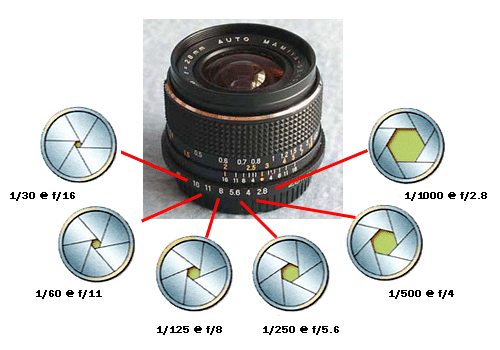Return
Home
Return to
Main
How-To
Page
If you would like to
make a donation to
help fund this site,
click below!
|
Understanding Reciprocity & Reciprocity
Failure

Various Aperture Size & Shutter Speed Combinations Yield the Same
Exposure = Reciprocity
As you may have guessed, there are numerous different - but equivalent
- combinations of shutter speed and f-stop that will produce exactly
the same exposure. This is the concept called "reciprocity." For example:
a small aperture such as f/16, combined with a shutter speed of 1/30,
will produce the same exposure as the larger f/11 aperture at 1/60;
or f/8 at 1/125.. Each combination doubles the light entering the
aperture compared to the previous setting, but cuts the time
it is allowed to enter in half. Still, in each case the same total
amount of light exposes the film.
Reciprocity Failure
However, at very long exposure times, the reciprocity concept fails
to hold true. The conventional relationship between aperture and shutter
speed breaks down, and it is typically called "reciprocity failure."
As shutter speeds get very slow (open for more than four-five seconds),
the chemical sensitivity of the film loses its reciprocal relationship
(actually, the same thing is true at extremely short exposures, but
it is rarely talked about since most mechanical cameras are incapable
of speeds approaching 1/10,000 second or less).
The non-technical explanation for this is that when the shutter is
opened for longer than it's "optimal" range, the film speed decreases.
In that case, the film responds much more slowly than usual, resulting
in underexposure. Reciprocity failure (also known as the
Schwarzschild
effect) is a decrease in light sensitivity (speed) with increased
length of exposure. The adjustment needs to made in the shutter speed, often
adding even more time to the exposure. Generally, the adjustments
needed to compensate for reciprocity failure are included on the data sheet
that comes inside the box of film. But for those whose appetite has been
whetted, here are some additional online sources:
It is by no means complete, but the items I am working
on so far are listed below (note: the line items in blue are live
page links; those items in black are still under construction):
If you would like a specific repair or instructional
item to be considered on this site, simply go to my Mamiya
35mm Forum! and make your suggestion known. I will add
it to the list of things to do. However, please don't hold your breath
waiting, because it is likely to be some time before I can get around
to documenting all the things that might need explanations, and I
would hate to be responsible for even small portions of the population
turning blue! Also, because mechanical and technical skills vary widely
from person to person, no liability for results or damage is either
expressed or implied in the use of these notations. |
| © 2000-2010 R.L.
Herron All Rights Reserved. Legal
|
| |
|
